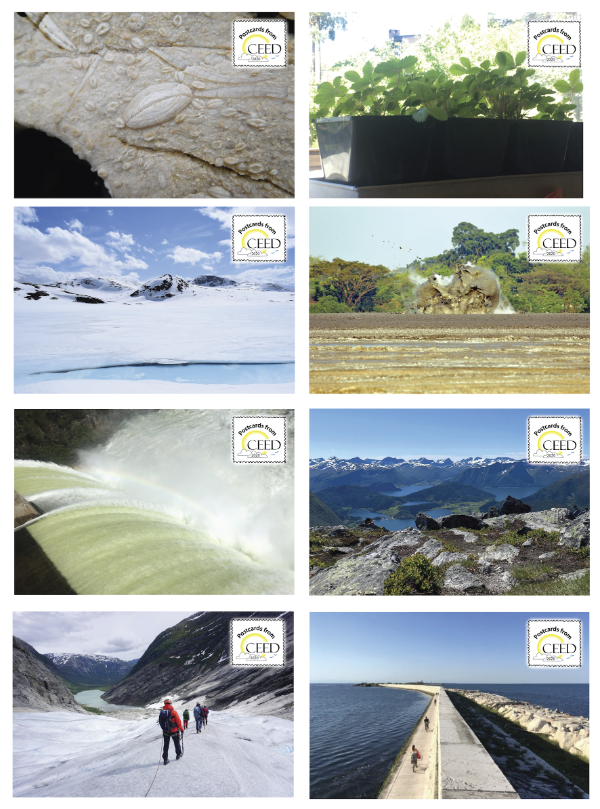
Captions: from top to bottom, left to right.
1. First #PostcardsfromCEED is PhD candidate Chloe Markussen Marcilly, who sends us photo of a nummulitic limestone of Eocene-Miocene age from the island of Vir in Croatia. At the center, we can see a nummulite macrofossil. Nummulites are fossils or living foraminiferan that form a calcareous skeleton. They are single-celled organisms with sizes ranging from microscopic scale to up to 5 cm. This one was circa 2 cm. These are really common of the Late paleocene-Mid Oligocene shallow marine carbonate deposits around the Mediterranean sea.
2. We've got mail ! Hope Jahren send us a#PostcardsfromCEED. With the CLIPT lab (http://jahrenlab.com/) closed for COVID-19 precautions, we’ve taken to experimenting with plants at home!
3. A #PostcardsfromCEED has arrived from Morgan Jones 🤩. The majestic frozen lake of Bygdin in southern Jotunheimen, Norway. The high elevation (1058 m a.s.l.) means ice only melts completely in July, allowing a brief time window when the local boat can ferry backpackers 15 km to the other end of the lake. In the winter, it is a perfect place to ski through the mountains.
4.Our next #PostcardsfromCEED is from Adriano Mazzini: Bledug Kuwu mud eruption, central Java, Indonesia. This locality displays constant bursting of mud and CO2-dominated gas producing spectacular shapes tens of cubic meters in size. The mechanisms driving this phenomena remain uncertain. #HOTMUD
5. #PostcardsfromCEED from Clint Conrad: View from the top of the dam at the Nomeland power plant, on the Otra river in southern Norway. The dam was built in 1920 and was one of the first projects to supply electricity to the city of Kristiansand. It has a 20 m waterfall and produces about 170 GWh of energy each year - that’s equivalent to about one quarter of Kristiansand’s annual electricity usage.
6. Postdoc Thea H. Heimdal sends us a#PostcardsfromCEED from 1086 asl from Tarløysa, Møre og Romsdal in Norway 🇳🇴🗻🥾. This is an area famous for the Romsdalseggen hike, but this alternative spot offers a view with slightly fewer tourists
7.#PostcardsfromCEED from PhD candidate Maaike Weerdesteijn who followed a week long glacier course at Jostedalsbreen to learn how to safely traverse glaciers. Here we see the view down from Nigardsbreen into the valley that was once carved by the glacier. Since 2003 this glacier arm has been retreating rapidly, with 80 meters over 2019 alone. In this process, loads of sediments are deposited in the glacial lake. The landscape is changing drastically due to climate change.
8. Ciao #PostcardsfromCEED from Sara Callegaro in Italy "The Pellestrina dam protects the Venice lagoon on the left (west) from the Adriatic Sea on the right (east). The Venice lagoon is an ephemeral environment that resists to these days only thanks to human interventions, with a complex equilibrium of salinity and a great biodiversity. The Serenissima Republic deviated the course of rivers to prevent terrigenous sediments from filling up the lagoon, fundamental for Venice and navigation. But nowadays, with the combined effects of sea level rise and local subsidence, the lagoon faces the opposite problem, and the Adriatic sea will most probably slowly engulf it."